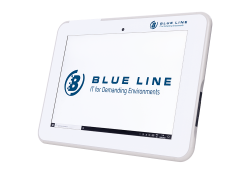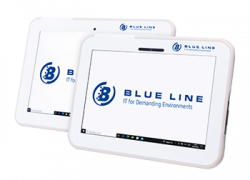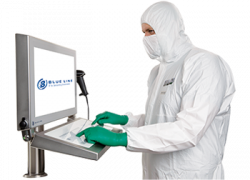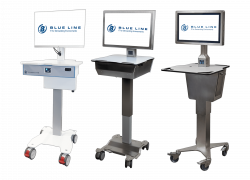Pharmaceutical and biotech industries are pushing to integrate rapidly advancing mobile technologies to reap the benefits of leaner modes of operation. Blue Line’s cleanroom tablets are such a solution, enabling operators greater mobility and enhancing documentation practices without requiring changes to established cleaning practices or creating workarounds with existing technologies.
Pharmaceutical and biotech manufacturing requires mobile technology to keep up with increasingly lean manufacturing practices and serialization. Mobile solutions are less cost-intensive in terms of acquisition costs and installation, allowing more flexible work practices, and can ease handover between shifts, preventing costly errors and wasted time. Blue Line pioneers a line of cleanroom tablets that will further improve cleanroom practices.
The lightest tablet on market
Existing tablets for demanding environments are typically designed for the healthcare industry, which means that while they withstand quick wipe downs, they will degrade quickly if subjected to more demanding cleaning practices and are still never fully cleanable because of groves, connectors, fans a.s.o.
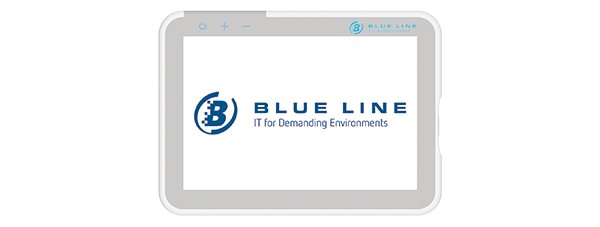
Stainless steel is a pharmaceutical technology standard because of its durability and resistance to even the harshest of cleaning agents. However, its weight makes it unsuitable for hand-carried tablets. Easily the most obvious advantage of tablets is their mobility, but that advantage disappears if operators find them too heavy to carry around. Existing tablets marketed for cleanroom are simply very heavy, upwards of 2 kg, which led to operators putting them on trolleys for regular use and this defeats the purpose of a tablet.
To ensure as thin and light a tablet as possible, Blue Line use an engineering polymer that serves as a suitable alternative to stainless steel. Commonly used in the aerospace industry, as well as in other demanding applications, this polymer is upwards of 80% lighter, almost as durable, and just as resistant to chemicals and biological contamination as 316 stainless steel. In this way, we provide a tablet weighing less than 1 kg without compromising on quality or computing power - it is about 60% lighter than competing tablets.
Near-perfect cleanability
Both GMP and FDA protocols concerning cleanroom technology require that devices be designed to withstand regular cleaning and minimize areas in which contaminants can hide. This can be problematic for commercial and healthcare tablets because most have a charging port, cooling vents, and buttons built in, all of which are places wherein contaminants can build up.
To address these problems, Blue Line’s cleanroom tablets are constructed out of a single piece of polymer to eliminate any creases. Further the design is fanless, without vents and buttons, and utilise a flush magnetic connector for charging and USB connectivity. To maintain the integrity, the tablets meet IP65 ingress protection.
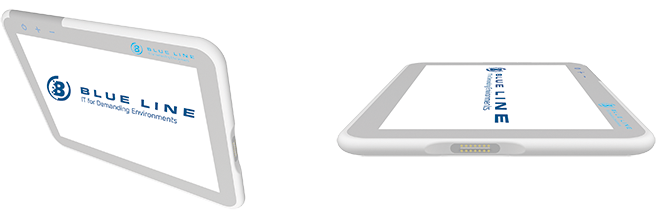
Touchscreen sensitivity is also important to consider, as cleanroom technicians typically wear multiple layers of personal protective equipment. Blue Line’s cleanroom tablets utilise projected capacitive multi-touch technology in their screens for that reason-echnicians can use them while wearing up to 3 layers of gloves
Enhancing communication and documentation
The use of tablets in cleanrooms is part of broader efforts in the pharmaceutical and biotech industry to digitalise cleanroom practices. Cleanroom tablets can enhance the connectivity of previously analogue practices like signing off on completed procedures or quickly inputting important changes in data. Moreover, when compared with mobile monitors, they are also far more flexible: Manufacturers can, for example, use tablets to trace and document particular batches, following them throughout its entire lifecycle from production to storage to shipping. In this way, data is consolidated and handover is efficient, allowing workers to quickly identify where, how, and when particular batches were made, stored, and transported.
The mobility and connectivity of cleanroom tablets also serves to prevent costly production errors by ensuring rapid, accurate communication between cleanroom staff and outside operational support staff. Good communication can mean the difference between batch spoilage-potentially costing the company millions of dollars-and successful production. Moreover, tablets enable more efficient and informed transmission of data to managers and upper-level staff.
Discover more details about the Cleanroom Tablets

